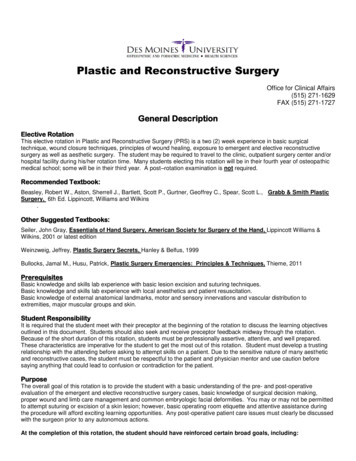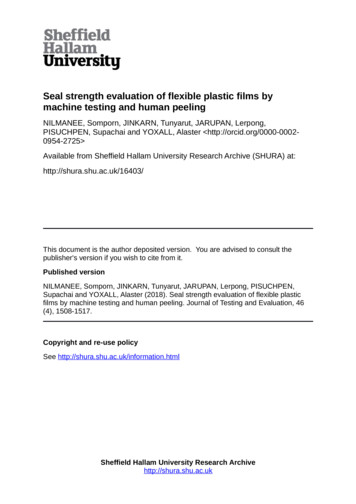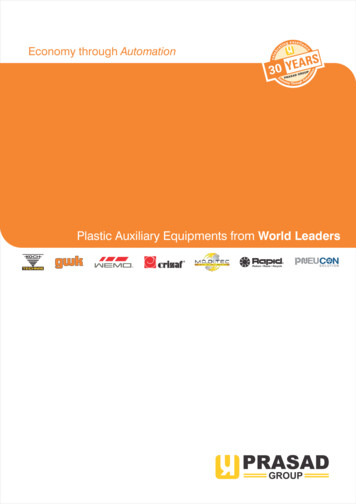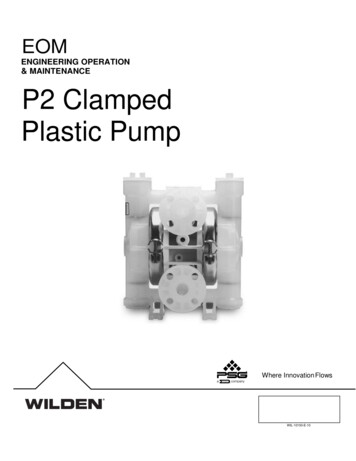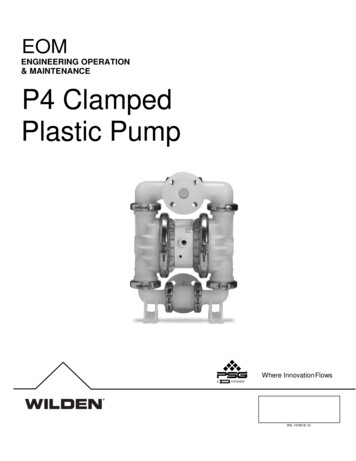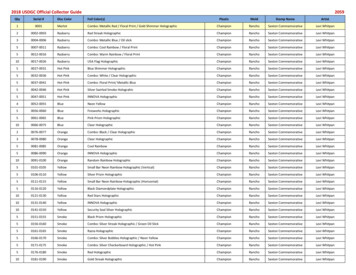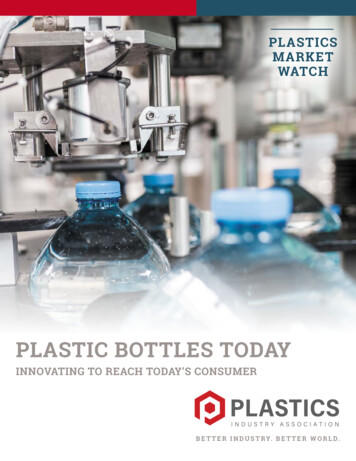
Transcription
PLASTICSMARKETWATCHPLASTIC BOTTLES TODAYINNOVATING TO REACH TODAY’S CONSUMERB E T T E R I N D U S T R Y. B E T T E R W O R L D .
February 2017The Plastics Industry Association (PLASTICS) sends special thanks to the BrandOwners, Processors and Equipment Councils, and Rigid Plastics Packaging Group(RPPG) for their guidance and input on this Bottling Plastics Market Watch Report.Materials were compiled, written and edited by William (Bill) Mashek, with editorialassistance from Kim Holmes, George Southworth, Kendra Martin and AshleyStoney at PLASTICS.Copyright Plastics Industry Association.02Plastics Market Watch—Watching: Bottling
Plastics Market WatchPlastic Bottles TodayInnovating to Reach Today’s ConsumerA series examining the business of plastics, includingdemographics, economics, policy developments andtechnological trends in specific plastics end markets.Contents05Forward08Introduction: Plastic Bottles Today—Innovating to Reach Today’s Consumer11Role of Plastics in Bottling16Growth of Plastics Bottling20Innovation25Plastic Bottle Economics29Bottling Equipment & Machinery31Recycling Progress37Conclusion42Plastic Bottle Glossary49Sources52Plastics Market Watch SnapshotPlastics Market Watch—Watching: Bottling03
04Plastics Market Watch—Watching: Bottling
Forward
The Plastics Industry Association’s (PLASTICS’) Plastics Market Watch reportsprovide forward-looking data and insights on key plastics industry end markets.The series examines the business of plastics, including demographics, economics,policy developments and technological improvements for markets includingautomotive and transportation, healthcare and medical devices, packaging, buildingand construction, automotive recycling, bioplastics and consumer electronics.Given the role that plastics play in today’s modern society, Plastics Market Watchreports offer a holistic picture of our technology—from beginning-of-life resins andpolymers to end-of-life management and recycling efforts. Our industry and membershave a responsibility to explain the whole picture of plastics and our industry; toooften the role of plastics is overshadowed by other technologies or misunderstood.For the average consumer—like a car buyer or a homebuyer—plastics’ contributionto their purchase is likely underestimated, but plastics are essential for a vehicle’sperformance, gas mileage and styling, and a home’s insulation, wiring and pipes. Therole of plastics within the consumer technology space is the same story: other partsof a television, drone or gaming system attract the attention of users, but plastics areessential to their design, function and performance.PLASTICS wants to explain the material’s role for our society as well as provideour members with forward-looking analysis of our key end markets in terms ofeconomic and demographic analytics that chart out our future. While a consumermay visualize one kind of plastic bottle, such as a water bottle, the fact is plasticbottles encompass a wide range of plastics, shapes and designs, contents andapplications. This Plastics Market Watch report will look at the reason for plasticbottling’s growth and expansion, including the diversity of plastics used in bottling,cost-effectiveness and savings in materials, safety, storage and shipping, andthe effectiveness of plastics’ ability to protect its contents. Innovation in plasticbottling—from polymers to molding equipment—advances at a significant pace,while the segment leads in recycling initiatives and success.Plastics Market WatchReports Available: Automotive andTransportation Healthcare andMedical Devices06 Packaging Bioplastics Building andConstruction ConsumerTechnology AutomotiveRecyclingPlastics Market Watch—Watching: Bottling
Chart 1Key Drivers for End KETConsumerTrendsPolicyPLASTICS intends for these Plastics Market Watch reports on key industryend markets to be a component of member companies’ strategic planning andintelligence gathering process. We welcome feedback and questions from ourmembers and look forward to presenting our reports and insights at futurePLASTICS gatherings and meetings.PLASTICS wants to explain plastics’ role for our society as well as provide ourmembers with forward-looking analysis of our key markets in terms of economicand demographic analytics that chart out our future. Consumer electronicsexemplifies the challenge our industry faces in articulating our contributions toa sector; at first blush, consumer electronics is a Silicon Valley-centric industrydefined by the Internet, software and applications, chips and advanced technologythat is transforming our economic and social landscapes. But on closer analysis,plastic is a key contributor to the consumer electronics sector because of itsprotective, light weighting properties, insulation and wiring qualities, and theflexible, safe design properties that are increasingly being used in products thatconsumers hold and use every hour of the day for their business, communication,health and entertainment.Plastics Market Watch—Watching: BottlingResourcesThis Plastics Market Watch reportwill offer members a current andforward-looking analysis of theConsumer Electronics sector interms of economic, demographicand technology trends in thesector—as well as public policyissues that are shaping the future ofthe sector.PLASTICS wants these PlasticsMarket Watch reports on keyindustry sectors to be a componentof member companies’ strategicplanning and intelligence gatheringprocess. We welcome feedback andquestions from members and lookforward to presenting our papersand insights at future PLASTICSgatherings and meetings.07
Introduction: Plastic BottlesToday—Innovating to ReachToday’s Consumer
Introduction: Plastic Bottles Today—Innovating to Reach Today’s ConsumerPlastic bottles have specific manufacturing and performance advantages overother packaging materials like aluminum, steel and glass that have helped plasticsexpand their market share of packaging materials. But with the growth of plasticbottling there is a heightened awareness of end-of-life (EOL) issues regardingtheir recycling and disposal. The plastics industry—and the entire value chain—has responded with sustainability efforts and educational endeavors. Yet plasticslitter—whether a recycled bale or a bottle floating on a waterway—is a visible andgalvanizing image that demonstrate the extremes of how plastics are managedafter they are used.Without question, plastic bottles have come a long way since their first commercialuses in the late 1940’s. The introduction of high-density polyethylene (HDPE) andpolyethylene terephthalate (PET) polymers expanded plastic bottling applications.Plastics then surpassed glass as the go-to packaging choice for a wide array ofproducts and brands.Plastics thensurpassedglass as the goto packagingchoice for awide array ofproducts andbrands.The importance of plastic bottles to PLASTICS’ membership—and the overallstakeholders like consumers, brands, policymakers and NGOs—is unquestioned.Bottling ranks high in PLASTICS’ data on the plastics industry’s output with onlypackaging film and sheet/plastics (except packaging) being higher in terms ofemployment numbers, value of industrial shipments and capital expenditures.Plastics Market Watch—Watching: Bottling09
negatively impacting natural systemslike the oceans and contributing tounsightly litter that can negativelyaffect tourism. But rather thancondemn plastics, the Foundationcalls for collaborative effort across thevalue chain for increased coordination,innovation and the introduction of newpackaging materials, and thousandsof small-scale local efforts to improvecollection, sorting and recycling effortsaround the globe.PLASTICS’ premier event NPE2018 willinclude a new feature, The Bottle Zone,an end-to-end exhibit on the NPE showfloor for companies and brand ownersin the beverage and bottling industries.The Bottle Zone will spotlightinnovations, technologies and solutionsfor the beverage bottling and PETmarkets. PLASTICS President and CEOWilliam R. Carteaux said, “Plastics areintegral to the bottling world’s ongoingsuccess and continued innovation.This vital industry segment hasn’thad a singular event and expositionwhere solutions providers and industryprofessionals can gather to exchangenew ideas, technologies and answersto the unique challenges facing thebeverage, bottling and PET market. TheBottle Zone at NPE2018 will changethat. This is where every company inthe bottling supply chain can connectwith market-leading equipment andsolution providers and access thecombined expertise they need to movetheir businesses forward.”In addition to exhibits, The Bottle Zonewill feature an education program on10the latest technological advancements,market insights and businessstrategies in the bottling industry,among other subjects.For brands using plastic bottles, thebenefits plastics packaging providesare measurable, but society hasequally benefited from plastic bottles.The Ellen MacArthur Foundationreported last year in its “The NewPlastics Economy” that plastics andplastic packaging are an integral partof the global economy and “imagininga world without plastics is nearlyimpossible.” Today’s food productionsupply chain depends upon plasticbottling and packaging.However, the Ellen MacArthurFoundation reported that whileplastics are “the workhorse materialof the modern economy,” the materialhas drawbacks. According to theMacArthur Foundation, 32 percent ofplastic packaging escapes collectionsystems altogether (predominantly inSoutheast Asia), generating significanteconomic costs (and losses) whilePLASTICS and its members are atthe center of this coordinated effortand commitment: advancing newpolymers and technologies, improvingperformance and making clearcommitments to recycling. Educationalefforts on recycling are ongoing andimproving, but the greatest changeneeded is the mindset of all consumersand stakeholders that a plastic bottleor container has real economic valuethrough recycling and the potentialto become a new bottle, new productand consumer or societal benefit. Thisis why PLASTICS supports effortslike The Recycling Partnership that isworking to expand access to recyclingopportunities for bottles and manyother forms of packaging and improvethe quality of the material returned tothe recycling system.The Bottling Plastics Market Watch isa resource showcasing the strengthof the bottling end market andthe plastics industry’s focus andcommitment to bottling. This reportprovides an opportunity to advancethe conversation in and out of theindustry leading up to NPE2018. In thecoming months, PLASTICS will help tobest position the industry in meetingthe needs of bottling brands and theirconsumers around the world whileaddressing the challenges that arekeeping us from advancing recovery.Plastics Market Watch—Watching: Bottling
Role of Plastics in Bottling
Role of Plastics in BottlingPlastics in Everyday ContainersPlastic bottles and jars represent approximately 75 percent of all plastic containers, by weight. While PET and high-densitypolyethylene (HDPE) represent approximately 86 percent of the plastic container market and are able to serve the bottlingneeds of most products on the market today, other types of plastics—including bioplastics and recycled plastics—are used fora wide range of bottling and packaging needs in a variety of industries, and are recyclable:PolyethyleneTerephthalate (PET,1PETE, PETG orPETEpolyester) is commonlyused for carbonated beverages, waterbottles and many food products likepeanut butter and jelly jars, andcooking oils. PET provides strongimpact resistance and tensile strength.PETG, one form of PET, offers greaterdesign freedoms than standard PETE,such as the ability to add handles toorange juice jugs. PET packaging hasexcellent barrier properties and alsooffers crystal clear transparency soconsumers can see the product.High DensityPolyethylene (HDPE) is2used for kitchen, bath andHDPElaundry bottles, as well asother consumer goods. HDPE iseconomical and impact resistant, andprovides a good moisture barrier. HDPEis compatible with a wide range ofproducts including acids and causticsbut is not compatible with solvents. Itcan be used for bottle caps, milk jugs,grocery bags, shampoo bottles, yogurttubs, detergent bottles, hard hats,12backpack frames, hula hoops, etc.HDPE is naturally translucent andflexible. The addition of color will makeHDPE opaque, but not glossy.Polyvinyl Chloride (PVC)is naturally clear plastic that3is extremely resistant to oilsVand chemicals and mostoften used in the toiletry and cosmeticmarket. It provides an excellent barrierto most gases and its drop impactresistance is also very good.Low DensityPolyethylene (LDPE) is4similar to HDPE inLDPEcomposition, but is lessrigid and less chemically resistant thanHDPE. LDPE is used primarily forsqueeze bottles (ketchup/mustard) aswell as food storage containers, film/shrink wrap, and bags (produce,grocery, trash, dry cleaning and bread).LDPE is a versatile and impactresistant and reusable plastic that isgenerally more expensive than HDPE.Despite specific initiatives to increaserecycling, its recycling rate is less thatPET and HDPE.Polypropylene (PP) isused primarily for jars,5medicine bottles andPPclosures, and provides arigid package with excellent moisturebarrier. PP is durable and versatile.Polystyrene (PS) offersexcellent clarity and6stiffness—glass-likePSquality—at an economicalcost. It is commonly used with dryproducts including vitamins, petroleumjellies and spices.Other Resins, likepolycarbonate (PC), are in7plastics bottles. PC is aOTHERclear plastics used tomake stiff, reusable personal waterbottles. PC is recycled with a variety ofplastic resins not identified by codes.Plastics Market Watch—Watching: Bottling
Overview of the ResinIdentification CodesThe Resin Identification Code (RIC) system was
economic and demographic analytics that chart out our future. While a consumer may visualize one kind of plastic bottle, such as a water bottle, the fact is plastic bottles encompass a wide range of plastics, shapes and designs, contents and applications. This Plastics Market Watch report will look at the reason for plastic bottling’s growth and expansion, including the diversity of plastics




